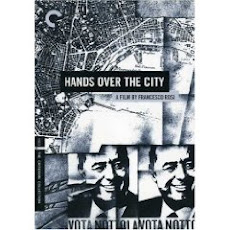
For now though, I want to take a look at one element of the film's world - the use of doubles and parallels, in characters, situations, and so on. The double is one of the great themes of German films - it's obviously not limited to German art, but it's probably not an accident that we use the German word for a doppelganger. Doubles and Faust figures - which is a variation on the double: the devil who grants power and wishes in exchange for the soul... The two combined in Student of Prague, one of the foundational German films - with a Mephistophilis figure taking the student's reflection as his price....
Mabuse is also something of a Faust story, though with Mabuse playing all the parts... But it also contains, within it, a fairly elaborate system of parallels among its characters. Mabuse himself has a double in state prosecutor Von Wenk - the film alternates between them, they are matched adversaries - Von Wenk dons disguises, like Mabuse, trying to move, undercover, through the underworld... Around them, the other major characters are arranged in pairs, sometimes loose, but usually fairly explicit. Cara Carozza, the dancer, loved (once) by Mabuse and now by Hull the playboy, is echoed in the figure of the Countess Told, caught between Von Wenk and Mabuse, replacing Carozza in Mabuse's love (or lust, or desire, or whatever it is); both women end up prisoners, and the countess identifies with Carozza... Hull the playboy, meanwhile, is doubled by the Count - both are rivals with Mabuse for a woman; both are ruined at cards by Mabuse's hypnosis; both draw Von Wenk into the story, and lead him closer to Mabuse. Both die, at Mabuse's orders, but both deaths contribute to Mabuse's own fall.
Meanwhile, the film itself is a double - released in two halves (like Kill Bill, or Che!), with scenes and situations repeated between the two films (sometimes within one half of the film). Scenes, games, situations, shots, are all repeated, replayed, with variations. Here, it will be easier to show than tell:
Here for example, are two shots, one from the first half, one from the second, of the Countess Told: in the first, she is at a gambling den, where she watches, uninvolved, curious - in the second, she is a prisoner of Mabuse, held in a room by herself.... She is unconscious in this shot, and helpless - a prisoner (itself a parallel, at that point in the film, to Carozza, who is being held prisoner by Von Wenk...). The shots are almost mirrors of one another - she's in a similar position, facing the opposite direction - with the color schemes almost reversed (dark covers, white covers - or look at how her dark dress in the second shot rhymes with the white feathers in the first one):


Or another parallel - both Mabuse and Told haunted by ghosts. Told is ruined by Mabuse hypnotizing him to cheat at cards - he sinks into madness and drink, seeing visions, pursued around his house -

only to end up forced to play cards with his own ghost:

A situation Mabuse repeats, almost exactly. Pursued by ghosts -

Forced to play cards by ghosts - who accuse him of cheating - as Told's ghosts accused him... (and notice the screen directions of all these shots: Told on the right, looking left, as he's pursued, then on the left, facing the ghosts during the card game; and Mabuse on the left during the pursuit, on the right for the card game...)

Mabuse, though, is different from the rest. He may be part of the system of doubles and parallels, but he is outside it somewhat as well. The simplest reason is that he is his own double - he keeps replacing himself. And here, as in some aspects of the structure of the film, the doubling principal becomes a serial principal - he is not a double so much as a series. And a series that, as the film goes on, and especially as we move to the sequels (The Testament of Dr. Mabuse, and onwards), becomes a mechanically reproduced series - first through words, but then through machines (loudspeakers and recordings) and so on. Copies of copies of copies, disembodied, dissipating into words, sounds, images... copies without originals... pages scattered on the floor.










1 comment:
Mabuse may be cinema's ultimate double--or, really, a double in the way only a movie character could be. I think, with the subsequent films, Lang explores (or exploits?) this quality to greater and greater degrees: the way an image (which Mabuse ultimately is--both as an actual film-image, and as a purely mental image, an abstract idea) can come to be connected with anything. For all of Lang's control, it's the audience that gives Mabuse power, by thinking about him in different terms, by applying him as an allegory to their experience.
Post a Comment